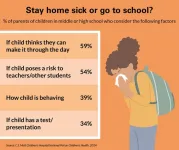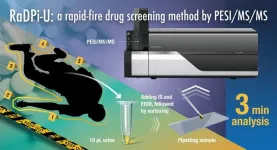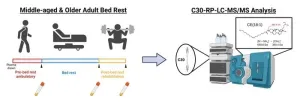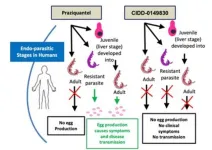(Press-News.org) In the United States, community health centers (CHCs) mainly serve historically marginalized populations. New research reveals that both before and during the COVID-19 pandemic, females receiving care at rural CHCs were less likely to be up to date with cervical cancer screening than those in urban CHCs. Factors associated with these differences included the proportion of patients with limited English proficiency and low income, as well as area-level unemployment and primary care physician density. The findings are published by Wiley online in CANCER, a peer-reviewed journal of the American Cancer Society.
In the analysis of data from CHCs in operation across all 50 states and the District of Columbia, investigators found that 38.2% of females receiving care at rural CHCs were up to date on cervical cancer screening during 2014–2019, compared with 43.0% of females receiving care at urban CHCs. This difference widened during the pandemic to 43.5% versus 49.0%.
The rural-urban difference in screening was mostly explained by differences in CHC-level proportions of patients with limited English proficiency. This accounted for 55.9% of the difference. Differences in the proportions of patients with income below the poverty level accounted for 12.3% of the rural-urban difference in screening, and the proportion of females aged 21–64 years accounted for 9.8% of the difference. Differences in area-level unemployment accounted for 3.4% of the difference, and differences in primary care physician density accounted for 3.2% of the difference. Differences between rural-urban CHCs were counterbalanced (meaning that differences were reduced) by the proportion of uninsured patients and patients with Medicaid coverage. (There were lower proportions of uninsured or Medicaid patients in rural CHCs. If rural CHCs had equal or larger proportions of uninsured or Medicaid patients as urban CHCs, the rural-urban gap would have been larger.)
The contributing factors’ effects on rural-urban differences in cervical cancer screening generally increased during the pandemic in 2020–2021.
“In our study, a higher proportion of patients best served in a language other than English in urban CHCs was the top contributor to rural-urban differences in up-to-date cervical cancer screening. A possible explanation for this finding might be greater access to language translation services in urban CHCs, as clinics serving a greater proportion of racial and ethnic minority groups are more likely to provide better translation services,” said lead author Hyunjung Lee, PhD, MS, MPP, MBA, of the American Cancer Society. “Increasing access to language translation services or adaptation of patient navigator interventions might improve completion and timeliness of cancer screening in CHCs and among patients with limited English proficiency, especially in rural CHCs. Insufficient funding remains a challenge to initiate and manage these activities, particularly in rural CHCs.”
Dr. Lee stressed that the prevalence of cervical cancer screening in CHCs is generally lower than in the general population, underscoring the need to improve cancer screening rates in both rural and urban CHCs to detect the disease at earlier stages, when treatment is most successful.
Additional information
NOTE: The information contained in this release is protected by copyright. Please include journal attribution in all coverage. A free abstract of this article will be available via the CANCER Newsroom upon online publication. For more information or to obtain a PDF of any study, please contact: Sara Henning-Stout, newsroom@wiley.com
Full Citation:
“Factors contributing to differences in cervical cancer screening in rural and urban community health centers.” Hyunjung Lee, Jordan Baeker Bispo, Parichoy Pal Choudhury, Daniel Wiese, Ahmedin Jemal, and Farhad Islami. CANCER; Published Online: March 25, 2024 (DOI: 10.1002/cncr.35265).
URL Upon Publication: http://doi.wiley.com/10.1002/cncr.35265
Author Contact: Anne Reynolds-Doerr, the American Cancer Society’s Director of Medical & Scientific Communications, at anne.doerr@cancer.org
About the Journal
CANCER is a peer-reviewed publication of the American Cancer Society integrating scientific information from worldwide sources for all oncologic specialties. The objective of CANCER is to provide an interdisciplinary forum for the exchange of information among oncologic disciplines concerned with the etiology, course, and treatment of human cancer. CANCER is published on behalf of the American Cancer Society by Wiley and can be accessed online. Follow CANCER on Twitter @JournalCancer and Instagram @ACSJournalCancer, and stay up to date with the American Cancer Society Journals on LinkedIn.
About Wiley
Wiley is a knowledge company and a global leader in research, publishing, and knowledge solutions. Dedicated to the creation and application of knowledge, Wiley serves the world’s researchers, learners, innovators, and leaders, helping them achieve their goals and solve the world's most important challenges. For more than two centuries, Wiley has been delivering on its timeless mission to unlock human potential. Visit us at Wiley.com. Follow us on Facebook, Twitter, LinkedIn and Instagram.
END
What factors contribute to differences in cervical cancer screening in rural and urban community health centers?
Study reveals English proficiency, income, and area-level unemployment are among the influential factors and highlights need for tailored interventions to increase screening rates
2024-03-25
ELSE PRESS RELEASES FROM THIS DATE:
2 in 3 parents say their adolescent or teen worries about how sick days may impact grades
2024-03-25
ANN ARBOR, Mich. – Many parents struggle deciding whether their middle or high school aged child should stay home from school if they don’t feel well, a new national poll suggests.
Among top factors: how their adolescent or teen is behaving due to symptoms and if they can get through a school day, the risk that they’re contagious and whether the student will miss a test, presentation or after school activity.
One in five parents also consider if their child needs a mental health day, according to the University of Michigan ...
Physician work hours, especially for male doctors, have declined since 1987
2024-03-25
Physicians in Canada, especially male physicians, are working fewer hours than they did 3 decades ago, and these long-term trends must be considered in workforce planning, according to new research in CMAJ (Canadian Medical Association Journal) https://www.cmaj.ca/lookup/doi/10.1503/cmaj.231166.
"Canadian physicians' work hours, crucial for health care access and planning, have seen a long-term decline, especially among male and married physicians, suggesting a shift towards better work–life balance," said Dr. Boris Kralj, Department of Economics, Centre for Health Economics & Policy Analysis, McMaster University, Hamilton, Ontario.
Using ...
RaDPi-U: A fast and convenient drug screening with urine samples
2024-03-25
Drugs, both legal and illegal, cause millions of cases of severe intoxication every year, leading to health complications and even fatalities. Often, they are also implicated in violent and sexual harassment crimes, as well as accidents. Obtaining detailed information about the drugs consumed by a criminal or victim is often challenging. Forensic professionals rely on drug screening techniques performed on biological samples, such as blood or saliva, to gather crucial evidence.
Today, various types of practical drug screening methods exist, each with their own unique advantages ...
Sweeping review reveals latest evidence on the diagnosis, treatment, and monitoring of ADHD
2024-03-25
Hundreds of studies are published each year on attention deficit hyperactivity disorder (ADHD), but more work is needed to ensure those findings improve lives.
With input from expert stakeholders across the field, researchers at the Southern California Evidence Review Center, part of the Keck School of Medicine of USC, have synthesized the latest insights so that they can ultimately inform clinical practice. Broadly, they found that both medications and psychosocial treatments work for treating ADHD and that children with the condition can and do get better.
“We have more research than ever on ADHD, but we need ...
The world is one step closer to secure quantum communication on a global scale
2024-03-25
Researchers at the University of Waterloo's Institute for Quantum Computing (IQC) have brought together two Nobel prize-winning research concepts to advance the field of quantum communication.
Scientists can now efficiently produce nearly perfect entangled photon pairs from quantum dot sources.
Entangled photons are particles of light that remain connected, even across large distances, and the 2022 Nobel Prize in Physics recognized experiments on this topic. Combining entanglement with quantum dots, a technology recognized with the Nobel Prize in Chemistry in 2023, the IQC research team aimed to optimize the ...
Political beliefs shape the way the public interprets history
2024-03-25
By exploring attitudes in the USA, UK, Italy, South Africa, Mexico, and Poland – countries with different economies, cultures and political regimes (past and present) – the paper shows that, in all countries, right- compared to left-wing supporters evaluated the past more positively.
The data reveal that, in part, this occurs because right-wing supporters are more nostalgic about tradition. While the right looked more favourably to the past, in the USA and Poland (and potentially in the UK too), the left was more ...
Researchers carry out first peer-reviewed study of fecal microbiota transplants in dolphins
2024-03-25
Scientists have successfully carried out pioneering fecal microbiota transplantations on Navy bottlenose dolphins that showed signs of gastrointestinal disease.
One dolphin in particular who was outwardly ill was able to be taken off medication during the treatment course, with his appetite and energy returning to normal, according to the team at the National Marine Mammal Foundation.
The project was carried out jointly between the NMMF, the U.S. Navy Marine Mammal Program and the Gilbert Lab at UCSD School of Medicine and Scripps Institution of Oceanography, and its findings were published in the Journal of ...
African catfish skin mucus yields promising antibacterial compound
2024-03-24
Scientists report they have extracted a compound with powerful antibacterial properties from the skin of farmed African catfish. Although additional testing is necessary to prove the compound is safe and effective for use as future antibiotic, the researchers say it could one day represent a potent new tool against antimicrobial-resistant bacteria such as extended-spectrum beta-lactamase (ESBL) producing E. coli.
Hedmon Okella is a postdoctoral researcher at the University of California, Davis, and led the project.
“The global public health threat due to antimicrobial resistance ...
Bedrest may affect cholesterol dynamics differently depending on age
2024-03-24
A new study examining cholesteryl esters suggests that periods of prolonged inactivity may affect people differently depending on their age. Cholesteryl esters — which consist of cholesterol molecules bonded with fatty acids — store and transport cholesterol throughout the body.
As people get older, their risk of being hospitalized or bedridden increases. These long periods of inactivity come with a host of negative health effects such as reduced insulin function and loss of lean muscle, bone mass and strength. Scientists are working to better understand the biology involved in these changes so that ...
New compound offers hope for deadly tropical disease
2024-03-24
A newly developed compound is showing promise in animal studies as a more effective treatment for human schistosomiasis, an understudied tropical disease caused by parasitic worms. The spread of schistosomiasis, a disease responsible for nearly 12,000 deaths globally each year, has been documented in 78 nations.
Although schistosomiasis transmission tends to occur in tropical and subtropical areas, climate change could shift it into new areas such as southern Europe. There is currently no vaccine available for the disease, which comes with severe clinical symptoms. The drug praziquantel is used for treatment. However, resistant mutations ...
LAST 30 PRESS RELEASES:
Electrodes created using light
Second-hand gift-giving is a well-deliberated decision
How human interaction drove evolution to make bears less aggressive
National Poll: Few parents offer teens guidance on healthy eating during holiday season
Cannabis derivatives could provide new ovarian cancer treatments
Raising strong yeast as a petroleum substitute
Clues to the origin of hot Jupiters hidden in their orbits
Canada’s reduced pledge to Global Fund will impact domestic health
1 in 4 children with major traumatic injuries not cared for in pediatric trauma centres
Duke and Duke-NUS’ joint cross-population research to uncover "East-West" differences in disease and care
Scientists to ‘spy’ on cancer- immune cell interactions using quantum technology breakthrough
Tech savvy users have most digital concerns
Making lighter work of calculating fluid and heat flow
Normalizing blood sugar can halve heart attack risk
Lowering blood sugar cuts heart attack risk in people with prediabetes
Study links genetic variants to risk of blinding eye disease in premature infants
Non-opioid ‘pain sponge’ therapy halts cartilage degeneration and relieves chronic pain
AI can pick up cultural values by mimicking how kids learn
China’s ecological redlines offer fast track to 30 x 30 global conservation goal
Invisible indoor threats: emerging household contaminants and their growing risks to human health
Adding antibody treatment to chemo boosts outcomes for children with rare cancer
Germline pathogenic variants among women without a history of breast cancer
Tanning beds triple melanoma risk, potentially causing broad DNA damage
Unique bond identified as key to viral infection speed
Indoor tanning makes youthful skin much older on a genetic level
Mouse model sheds new light on the causes and potential solutions to human GI problems linked to muscular dystrophy
The Journal of Nuclear Medicine ahead-of-print tip sheet: December 12, 2025
Smarter tools for peering into the microscopic world
Applications open for funding to conduct research in the Kinsey Institute archives
Global measure underestimates the severity of food insecurity
[Press-News.org] What factors contribute to differences in cervical cancer screening in rural and urban community health centers?Study reveals English proficiency, income, and area-level unemployment are among the influential factors and highlights need for tailored interventions to increase screening rates





